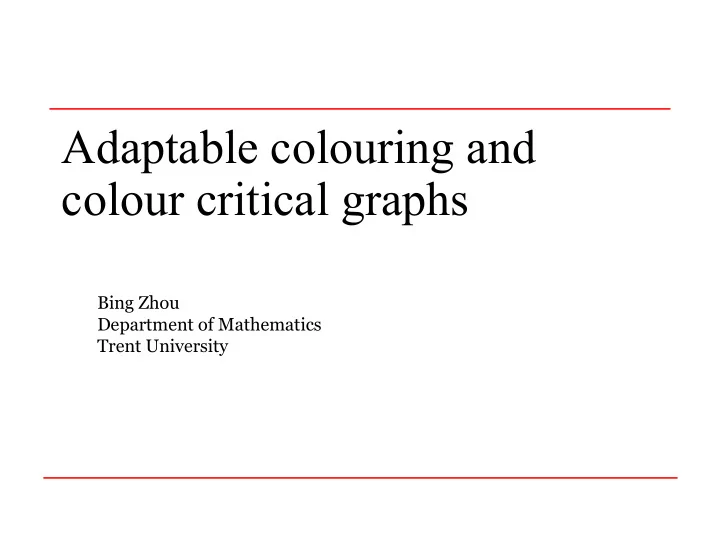

Adaptable colouring and colour critical graphs Bing Zhou Department of Mathematics Trent University
Adapted k -colouring of graphs Definitions. A graph G is adaptably k - colourable if for every k -edge colouring c ’, there is a k -vertex colouring c such that for every edge xy in G , not all of c ( x ), c ( y ), and c ’( xy ) are the same. The edge xy is monochromatic if c ( x )= c ( y )= c ’( xy ). The adaptable chromatic number of G , χ a ( G ), is the least k such that G is adaptably k -colourable.
Adapted k -colouring as a game • There are two players E and V. • Player E colours the edges of a graph G first using colours in {1,2,…, k }. • Player V then colours vertices of G using the same set of colours. • Player V wins if he can colour the vertices without creating any monochromatic edges. • Otherwise E wins.
Adapted k -colouring as a game • The least number of colours that player V always has a winning strategy is the adaptable chromatic number of G , χ a ( G ).
Example. K 4 • Consider the graph K 4:
A 2-edge colouring of K 4. • E colours the edges in two colours:
An adapted 2-colouring • V colours the vertices in two colours: There is no monochromatic edge.
A winning strategy for E with 2 colours • E has a winning strategy with two colours: Therefore χ a ( K 4 ) > 2.
A winning strategy of V with 3 colours χ a ( K 4 ) = 3.
Colour critical graphs • A graph G is k -critical if χ( G ) = k and χ( G ˗ e ) = k – 1 for every edge e in G . • A k -critical graph can be coloured with k – 1 colours such that there is only one edge joining two vertices of the same colour. Fact. If G is k -critical then χ a ( G ) ≤ k ˗ 1. Problem. ( Molloy and Thron 2012) Are there any critical graphs G with χ a ( G ) = χ( G ) ˗ 1 ?
Construction 1 •
Construction 1 Let G be the graph obtained by applying the Hajós’ construction to two graphs G 1 and G 2. Fact. If both G 1 and G 2 are k -critical, then G is also k -critical. Fact. (Huizenga 2008) If χ a ( G 1) ≥ k and χ a ( G 2) ≥ k , then χ a ( G ) ≥ k. Implication. If there is a k -critical graph G with χ a ( G ) = k ˗ 1 then there are infinitely many such graphs.
Construction 2 •
Construction 2 •
The graph W 5 W 5 W 5 is 4-critical. χ a ( W 5 ) ≥ 3. Therefore, χ a ( W 5 ) = 3.
An important property of W 5 W 5 has a proper subgraph H 4 such that χ a ( H 4 ) = 3.
The construction for k = 5. (1) We apply Hajós’ construction to two copies of W 5.
The construction for k = 5. (2) We apply Hajós’ construction one more time.
The construction for k = 5. (3) We continue applying Hajós’ construction to get this graph F 4. F 4 is 4-critical.
The construction for k = 5. (4) F 4 contains three disjoint copies of H 4. = K 1 ∨ F 4 . G 5
The construction for k = 5. (5) G 5 is 5-critical. Therefore χ a ( G 5) ≤ 4. Claim. χ a ( G 5) ≥ 4. We show that Player E has a winning strategy with 3 colours on G 5.
General case Theorem. For every integer k such that k ≥ 4, there is a k -critical graph Gk that contains a proper subgraph Hk such that χ a ( Hk ) ≥ k ˗ 1.
K 4 again. • χ( K 4) = 4 and χ( K 4 ˗ e ) = 3 for every edge e in K 4. • χ a ( K 4) = 3. • χ a ( K 4 ˗ e ) = 2 for every edge e in K 4. Question. Are there any other such “double critical” graphs G with χ a = χ( G ) ˗ 1 ?
The Grötzsch graph Let G be the Grötzsch graph. Fact. G is 4-critical. Fact. G is triangle-free.
The Grötzsch graph Fact. χ a ( G ) = 3 . Player E has a winning strategy if there are two colours. Fact. There are triangle-free 4-critical graphs with adaptable chromatic number 3.
More questions • Question 1: Are there triangle-free k -critical graphs with adaptable chromatic number k -1 for every k ≥5? • Question 2: Are there k -critical graphs with adaptable chromatic number k -1 and girth g for every k ≥4 and g ≥4?
Lower bound •
Lower bound (2) •
Still more questions •
Recommend
More recommend